Pressure Ulcer Management in Critically Ill Patients
VerifiedAdded on 2023/05/30
|9
|2438
|314
AI Summary
This essay discusses the benefits of evidence-based practice in pressure ulcer management for critically ill patients in intensive care units. It explores the steps of EBP and suggests interventions based on literature evidence.
Contribute Materials
Your contribution can guide someone’s learning journey. Share your
documents today.
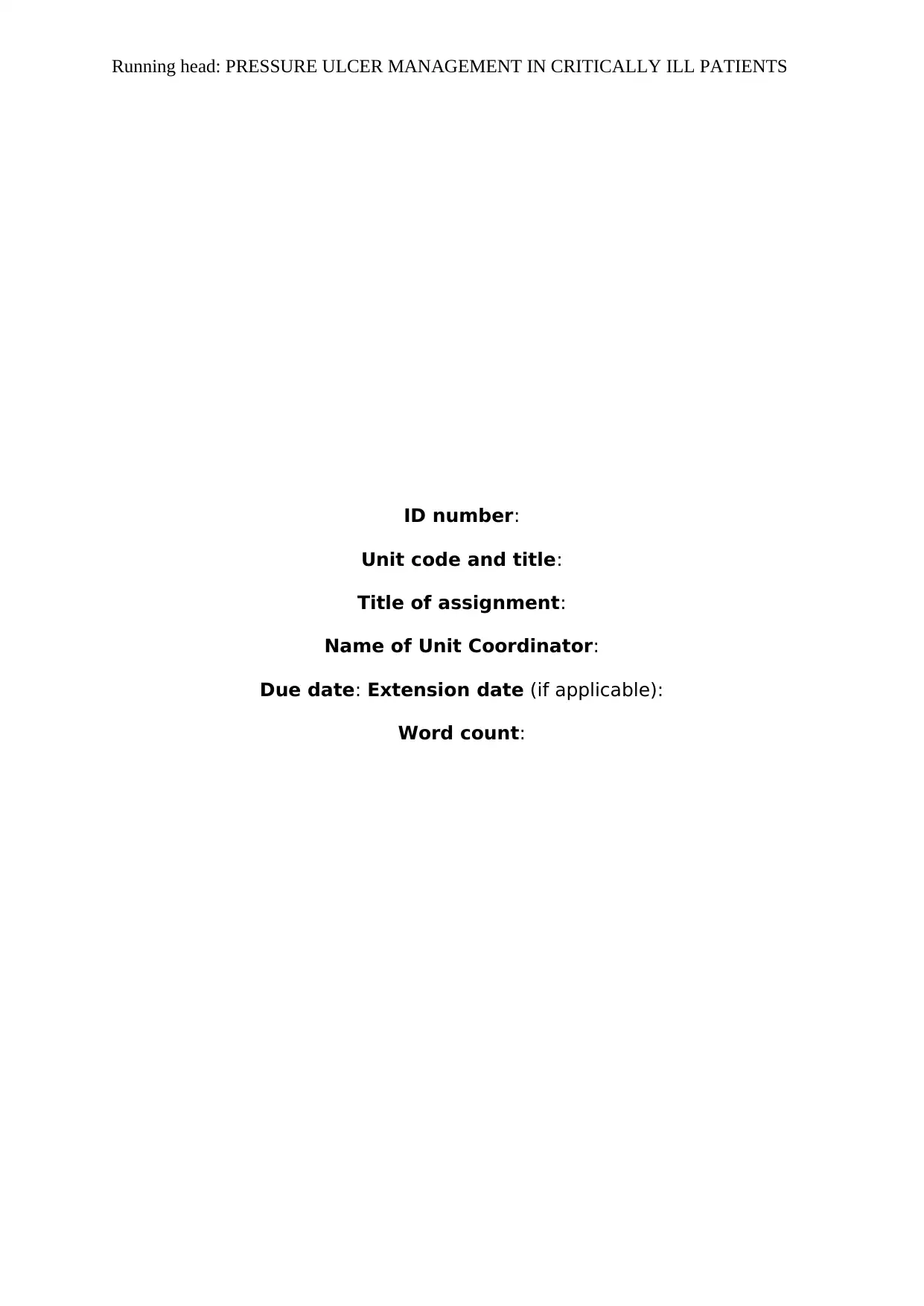
Running head: PRESSURE ULCER MANAGEMENT IN CRITICALLY ILL PATIENTS
ID number:
Unit code and title:
Title of assignment:
Name of Unit Coordinator:
Due date: Extension date (if applicable):
Word count:
ID number:
Unit code and title:
Title of assignment:
Name of Unit Coordinator:
Due date: Extension date (if applicable):
Word count:
Secure Best Marks with AI Grader
Need help grading? Try our AI Grader for instant feedback on your assignments.

1
PRESSURE ULCER MANAGEMENT IN CRITICALLY ILL PATIENTS
Introduction:
The nursing practice is evolving every day, and as a result the impact of the
technological innovations and infrastructural changes have helped in the evolution of a
patient care techniques and care delivery formats (Giger, 2016). The evidence based practice
can be defined as one such patient care delivery format which has helped in the improvement
of care quality and safety drastically in the past few decades (Murdaugh, Parsons & Pender,
2018). The evidence based practice has revolutionized the care delivery scenario drastically
in the last few decades. It has not only reduced an instances of medication errors and
communication errors, but it has also improve the quality and patent centeredness of the care
provided to the patients. This essay will attempt to employ the benefits of evidence based
practice in the context of pressure ulcer management in critically ill patients in intensive care
units.
Context or area of concern:
First and foremost, it is essential to identify and explore the area of concern for the
paper. In this case, the chosen area for concern is the pressure injury management for the
critically ill patients, in intensive care units. It has to be mentioned in this context that
critically ill patients are mostly immune-compromised which enhances their probability of
obtained pressure ulcers. As discussed by Santamaria et al. (2015), close to one fourth of the
total ICU patient population has been suffering from pressure injuries which not only
enhances complications to exacerbations that the patient is already suffering from, but also
enhances the health care costs and not of days in hospice care. As a result, the need for
intervention and strategic recommendations to overcome the risk of pressure injuries in the
ICU environment is a major requirement for the ICU care staff. Evidence based practice can
help improve the pressure injury management scenario drastically and along with that,
improve the quality of life of the patient population as well.
PRESSURE ULCER MANAGEMENT IN CRITICALLY ILL PATIENTS
Introduction:
The nursing practice is evolving every day, and as a result the impact of the
technological innovations and infrastructural changes have helped in the evolution of a
patient care techniques and care delivery formats (Giger, 2016). The evidence based practice
can be defined as one such patient care delivery format which has helped in the improvement
of care quality and safety drastically in the past few decades (Murdaugh, Parsons & Pender,
2018). The evidence based practice has revolutionized the care delivery scenario drastically
in the last few decades. It has not only reduced an instances of medication errors and
communication errors, but it has also improve the quality and patent centeredness of the care
provided to the patients. This essay will attempt to employ the benefits of evidence based
practice in the context of pressure ulcer management in critically ill patients in intensive care
units.
Context or area of concern:
First and foremost, it is essential to identify and explore the area of concern for the
paper. In this case, the chosen area for concern is the pressure injury management for the
critically ill patients, in intensive care units. It has to be mentioned in this context that
critically ill patients are mostly immune-compromised which enhances their probability of
obtained pressure ulcers. As discussed by Santamaria et al. (2015), close to one fourth of the
total ICU patient population has been suffering from pressure injuries which not only
enhances complications to exacerbations that the patient is already suffering from, but also
enhances the health care costs and not of days in hospice care. As a result, the need for
intervention and strategic recommendations to overcome the risk of pressure injuries in the
ICU environment is a major requirement for the ICU care staff. Evidence based practice can
help improve the pressure injury management scenario drastically and along with that,
improve the quality of life of the patient population as well.
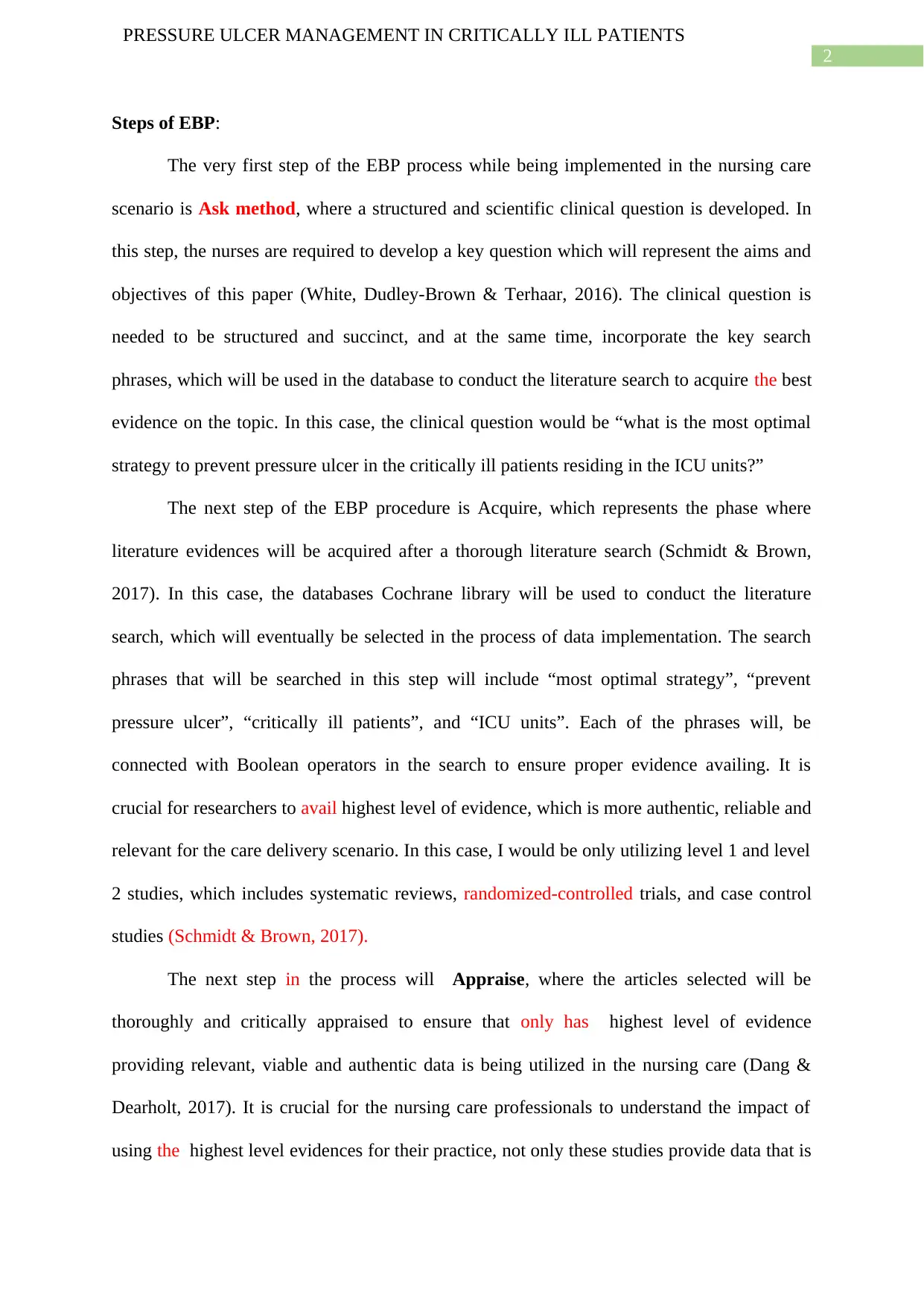
2
PRESSURE ULCER MANAGEMENT IN CRITICALLY ILL PATIENTS
Steps of EBP:
The very first step of the EBP process while being implemented in the nursing care
scenario is Ask method, where a structured and scientific clinical question is developed. In
this step, the nurses are required to develop a key question which will represent the aims and
objectives of this paper (White, Dudley-Brown & Terhaar, 2016). The clinical question is
needed to be structured and succinct, and at the same time, incorporate the key search
phrases, which will be used in the database to conduct the literature search to acquire the best
evidence on the topic. In this case, the clinical question would be “what is the most optimal
strategy to prevent pressure ulcer in the critically ill patients residing in the ICU units?”
The next step of the EBP procedure is Acquire, which represents the phase where
literature evidences will be acquired after a thorough literature search (Schmidt & Brown,
2017). In this case, the databases Cochrane library will be used to conduct the literature
search, which will eventually be selected in the process of data implementation. The search
phrases that will be searched in this step will include “most optimal strategy”, “prevent
pressure ulcer”, “critically ill patients”, and “ICU units”. Each of the phrases will, be
connected with Boolean operators in the search to ensure proper evidence availing. It is
crucial for researchers to avail highest level of evidence, which is more authentic, reliable and
relevant for the care delivery scenario. In this case, I would be only utilizing level 1 and level
2 studies, which includes systematic reviews, randomized-controlled trials, and case control
studies (Schmidt & Brown, 2017).
The next step in the process will Appraise, where the articles selected will be
thoroughly and critically appraised to ensure that only has highest level of evidence
providing relevant, viable and authentic data is being utilized in the nursing care (Dang &
Dearholt, 2017). It is crucial for the nursing care professionals to understand the impact of
using the highest level evidences for their practice, not only these studies provide data that is
PRESSURE ULCER MANAGEMENT IN CRITICALLY ILL PATIENTS
Steps of EBP:
The very first step of the EBP process while being implemented in the nursing care
scenario is Ask method, where a structured and scientific clinical question is developed. In
this step, the nurses are required to develop a key question which will represent the aims and
objectives of this paper (White, Dudley-Brown & Terhaar, 2016). The clinical question is
needed to be structured and succinct, and at the same time, incorporate the key search
phrases, which will be used in the database to conduct the literature search to acquire the best
evidence on the topic. In this case, the clinical question would be “what is the most optimal
strategy to prevent pressure ulcer in the critically ill patients residing in the ICU units?”
The next step of the EBP procedure is Acquire, which represents the phase where
literature evidences will be acquired after a thorough literature search (Schmidt & Brown,
2017). In this case, the databases Cochrane library will be used to conduct the literature
search, which will eventually be selected in the process of data implementation. The search
phrases that will be searched in this step will include “most optimal strategy”, “prevent
pressure ulcer”, “critically ill patients”, and “ICU units”. Each of the phrases will, be
connected with Boolean operators in the search to ensure proper evidence availing. It is
crucial for researchers to avail highest level of evidence, which is more authentic, reliable and
relevant for the care delivery scenario. In this case, I would be only utilizing level 1 and level
2 studies, which includes systematic reviews, randomized-controlled trials, and case control
studies (Schmidt & Brown, 2017).
The next step in the process will Appraise, where the articles selected will be
thoroughly and critically appraised to ensure that only has highest level of evidence
providing relevant, viable and authentic data is being utilized in the nursing care (Dang &
Dearholt, 2017). It is crucial for the nursing care professionals to understand the impact of
using the highest level evidences for their practice, not only these studies provide data that is

3
PRESSURE ULCER MANAGEMENT IN CRITICALLY ILL PATIENTS
relevant and is free form bias as much as possible. But it also ensures that the researchers will
be able to understand whether the evidence that is being provided is transferable to their won
target patent setting or not. In this case, I would be utilizing the CRAAP checklist to evaluate
and critically appraise the literature evidence. This particular checklist assesses the currency,
relevance, authority, accuracy, and purpose of the study, and hence, this checklist will be
excellent for me to ensure that the studies included are authentic and worthy to be used in
nursing care.
The next step in the process is Apply method, in this step, the evidence availed from
the internet is evaluated and applied to the present care scenario (LoBiondo-Wood & Haber,
2017). In this case, three studies have been selected to be finally compared and contrasted to
be eventually employed in the care delivery scenario. In this case, the first article is by
Kalowes, Messina and Li, (2016), in where the authors have employed a randomized-control
trial study design to discover the effectiveness of the five layered soft silicone dressing in
order to prevent pressure ulcer in ICU. The data findings indicated the fact that incidence rate
of HAPUs or health care associated pressure ulcers was significantly reduced in the ICU
setting that had been treated with the foam dressing. The authors have concluded on the fact
that the use of soft silicon foams along with preventative care helped reduce the incidence of
pressure ulcers drastically.
Similarly, another randomized control trial by Santamaria et al. (2015)has attempted
to investigate the effectiveness of multi‐layered soft silicone foam dressings in preventing
intensive care unit (ICU), involving 440 trauma patients. The data revealed the fact that
multi‐layered soft silicone foam dressings reduced the incidence of acquiring pressure ulcers
by a 10% rate, which is commendable. Although, the impact of the dressing was only
reported to be effective when applied in the emergency department prior to ICU transfer.
Lastly, the article is a systematic review with the meta-analysis by Huang et al.
PRESSURE ULCER MANAGEMENT IN CRITICALLY ILL PATIENTS
relevant and is free form bias as much as possible. But it also ensures that the researchers will
be able to understand whether the evidence that is being provided is transferable to their won
target patent setting or not. In this case, I would be utilizing the CRAAP checklist to evaluate
and critically appraise the literature evidence. This particular checklist assesses the currency,
relevance, authority, accuracy, and purpose of the study, and hence, this checklist will be
excellent for me to ensure that the studies included are authentic and worthy to be used in
nursing care.
The next step in the process is Apply method, in this step, the evidence availed from
the internet is evaluated and applied to the present care scenario (LoBiondo-Wood & Haber,
2017). In this case, three studies have been selected to be finally compared and contrasted to
be eventually employed in the care delivery scenario. In this case, the first article is by
Kalowes, Messina and Li, (2016), in where the authors have employed a randomized-control
trial study design to discover the effectiveness of the five layered soft silicone dressing in
order to prevent pressure ulcer in ICU. The data findings indicated the fact that incidence rate
of HAPUs or health care associated pressure ulcers was significantly reduced in the ICU
setting that had been treated with the foam dressing. The authors have concluded on the fact
that the use of soft silicon foams along with preventative care helped reduce the incidence of
pressure ulcers drastically.
Similarly, another randomized control trial by Santamaria et al. (2015)has attempted
to investigate the effectiveness of multi‐layered soft silicone foam dressings in preventing
intensive care unit (ICU), involving 440 trauma patients. The data revealed the fact that
multi‐layered soft silicone foam dressings reduced the incidence of acquiring pressure ulcers
by a 10% rate, which is commendable. Although, the impact of the dressing was only
reported to be effective when applied in the emergency department prior to ICU transfer.
Lastly, the article is a systematic review with the meta-analysis by Huang et al.
Secure Best Marks with AI Grader
Need help grading? Try our AI Grader for instant feedback on your assignments.

4
PRESSURE ULCER MANAGEMENT IN CRITICALLY ILL PATIENTS
(2015), which suggests that the implementation of dressing, various types including
hydrocolloid, foam, silicon and other types help in reducing the risk of acquiring pressure
ulcers or injuries to a large extent. Hence, the evidence base dictates that the impact of silicon
or foam based dressing helps in reducing the risk to a huge extent, and it can be safely
applied to the ICU care setting as well. Hence, this intervention would be applied to the care
setting as well.
The last step of the entire EBP implementation process is the audit, which entails
checking the impact that the implementation of the process has brought forward in the care
setting (Dang & Dearholt, 2017). In this case, care intervention had been the introduction of
soft multilayered silicone foam dressings for the critically ill in ICU units, and to investigate
whether the intervention implementation reduced the risk of patients acquiring pressure
injuries or not. In this case, I would first and foremost present the idea of practice change
using the silicone foam dressing to the nursing manager. I would present her with the data
that i have gathered from the literature search along with the three articles that I have
reviewed in the process with their data findings to capture the attention of the facility.
additionally i would also propose the idea of a training the ICU nursing staff regarding the
correct use of the dressing and additional precautionary measures to ensure reaping the most
benefits out of the intervention before the change was implemented in the entire facility. At
the end of a month of pilot application on 10 patients chosen randomly, data would be
collected on HAPU from the respective bedside nurses and with respect to the results, the
verdict will be taken on whether the intervention is worthy of being employed throughout the
facility (White, Dudley-Brown & Terhaar, 2016).
Conclusion:
On a concluding note, this essay provided me with ample opportunity to employ the
steps of evidence based practice in a real world like care setting. Each of the step design gave
PRESSURE ULCER MANAGEMENT IN CRITICALLY ILL PATIENTS
(2015), which suggests that the implementation of dressing, various types including
hydrocolloid, foam, silicon and other types help in reducing the risk of acquiring pressure
ulcers or injuries to a large extent. Hence, the evidence base dictates that the impact of silicon
or foam based dressing helps in reducing the risk to a huge extent, and it can be safely
applied to the ICU care setting as well. Hence, this intervention would be applied to the care
setting as well.
The last step of the entire EBP implementation process is the audit, which entails
checking the impact that the implementation of the process has brought forward in the care
setting (Dang & Dearholt, 2017). In this case, care intervention had been the introduction of
soft multilayered silicone foam dressings for the critically ill in ICU units, and to investigate
whether the intervention implementation reduced the risk of patients acquiring pressure
injuries or not. In this case, I would first and foremost present the idea of practice change
using the silicone foam dressing to the nursing manager. I would present her with the data
that i have gathered from the literature search along with the three articles that I have
reviewed in the process with their data findings to capture the attention of the facility.
additionally i would also propose the idea of a training the ICU nursing staff regarding the
correct use of the dressing and additional precautionary measures to ensure reaping the most
benefits out of the intervention before the change was implemented in the entire facility. At
the end of a month of pilot application on 10 patients chosen randomly, data would be
collected on HAPU from the respective bedside nurses and with respect to the results, the
verdict will be taken on whether the intervention is worthy of being employed throughout the
facility (White, Dudley-Brown & Terhaar, 2016).
Conclusion:
On a concluding note, this essay provided me with ample opportunity to employ the
steps of evidence based practice in a real world like care setting. Each of the step design gave

5
PRESSURE ULCER MANAGEMENT IN CRITICALLY ILL PATIENTS
me an excellent chance to understand exactly how to carry out each step effectively and
successfully. evidence based practice is a core competence, and each and every nursing
professional is required to have a prowess at implementing evidence based practice. This
essay helped me discover my strengths and weaknesses which in turn will help me excel in
my clinical practice as a nurse in the future.
PRESSURE ULCER MANAGEMENT IN CRITICALLY ILL PATIENTS
me an excellent chance to understand exactly how to carry out each step effectively and
successfully. evidence based practice is a core competence, and each and every nursing
professional is required to have a prowess at implementing evidence based practice. This
essay helped me discover my strengths and weaknesses which in turn will help me excel in
my clinical practice as a nurse in the future.
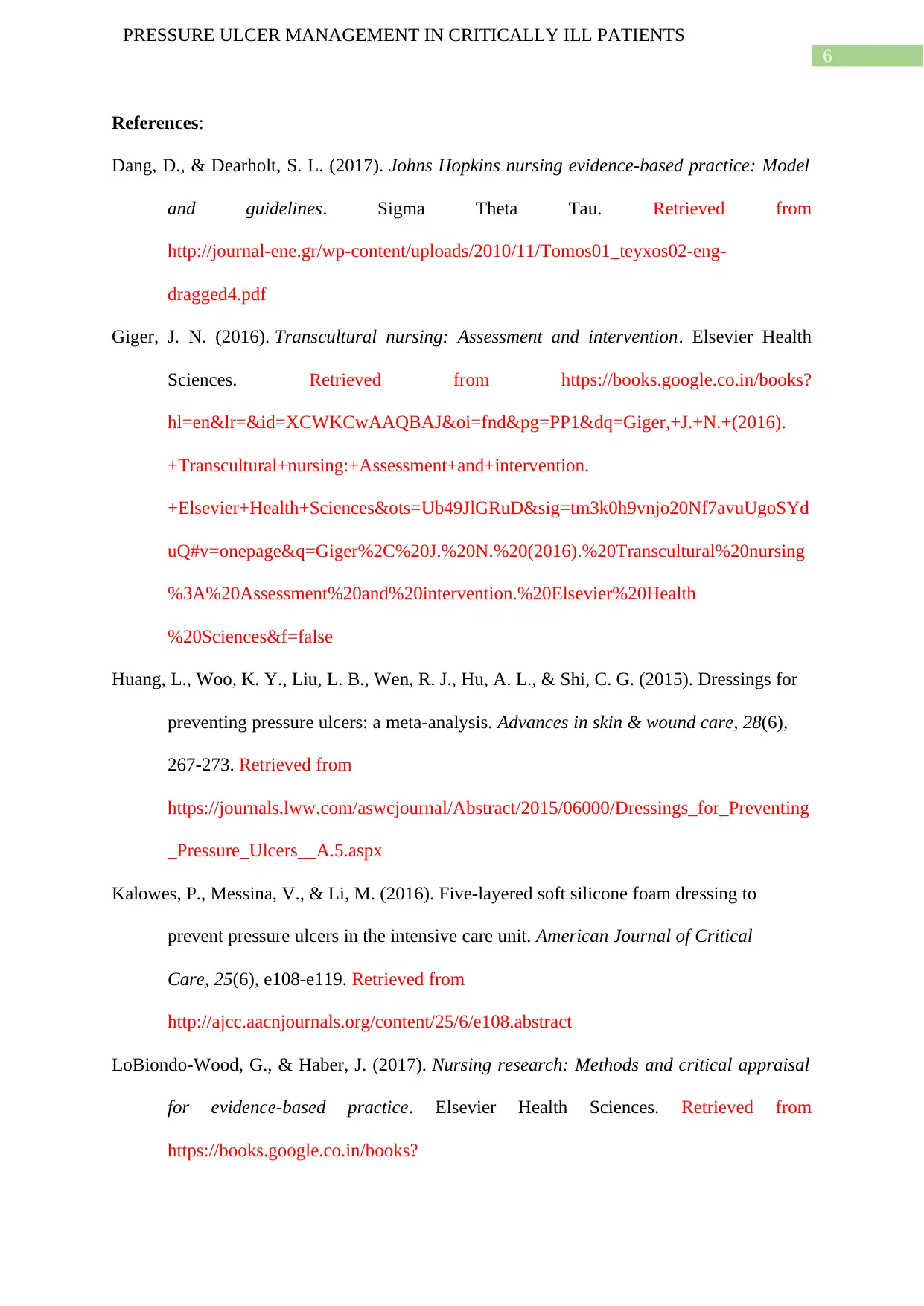
6
PRESSURE ULCER MANAGEMENT IN CRITICALLY ILL PATIENTS
References:
Dang, D., & Dearholt, S. L. (2017). Johns Hopkins nursing evidence-based practice: Model
and guidelines. Sigma Theta Tau. Retrieved from
http://journal-ene.gr/wp-content/uploads/2010/11/Tomos01_teyxos02-eng-
dragged4.pdf
Giger, J. N. (2016). Transcultural nursing: Assessment and intervention. Elsevier Health
Sciences. Retrieved from https://books.google.co.in/books?
hl=en&lr=&id=XCWKCwAAQBAJ&oi=fnd&pg=PP1&dq=Giger,+J.+N.+(2016).
+Transcultural+nursing:+Assessment+and+intervention.
+Elsevier+Health+Sciences&ots=Ub49JlGRuD&sig=tm3k0h9vnjo20Nf7avuUgoSYd
uQ#v=onepage&q=Giger%2C%20J.%20N.%20(2016).%20Transcultural%20nursing
%3A%20Assessment%20and%20intervention.%20Elsevier%20Health
%20Sciences&f=false
Huang, L., Woo, K. Y., Liu, L. B., Wen, R. J., Hu, A. L., & Shi, C. G. (2015). Dressings for
preventing pressure ulcers: a meta-analysis. Advances in skin & wound care, 28(6),
267-273. Retrieved from
https://journals.lww.com/aswcjournal/Abstract/2015/06000/Dressings_for_Preventing
_Pressure_Ulcers__A.5.aspx
Kalowes, P., Messina, V., & Li, M. (2016). Five-layered soft silicone foam dressing to
prevent pressure ulcers in the intensive care unit. American Journal of Critical
Care, 25(6), e108-e119. Retrieved from
http://ajcc.aacnjournals.org/content/25/6/e108.abstract
LoBiondo-Wood, G., & Haber, J. (2017). Nursing research: Methods and critical appraisal
for evidence-based practice. Elsevier Health Sciences. Retrieved from
https://books.google.co.in/books?
PRESSURE ULCER MANAGEMENT IN CRITICALLY ILL PATIENTS
References:
Dang, D., & Dearholt, S. L. (2017). Johns Hopkins nursing evidence-based practice: Model
and guidelines. Sigma Theta Tau. Retrieved from
http://journal-ene.gr/wp-content/uploads/2010/11/Tomos01_teyxos02-eng-
dragged4.pdf
Giger, J. N. (2016). Transcultural nursing: Assessment and intervention. Elsevier Health
Sciences. Retrieved from https://books.google.co.in/books?
hl=en&lr=&id=XCWKCwAAQBAJ&oi=fnd&pg=PP1&dq=Giger,+J.+N.+(2016).
+Transcultural+nursing:+Assessment+and+intervention.
+Elsevier+Health+Sciences&ots=Ub49JlGRuD&sig=tm3k0h9vnjo20Nf7avuUgoSYd
uQ#v=onepage&q=Giger%2C%20J.%20N.%20(2016).%20Transcultural%20nursing
%3A%20Assessment%20and%20intervention.%20Elsevier%20Health
%20Sciences&f=false
Huang, L., Woo, K. Y., Liu, L. B., Wen, R. J., Hu, A. L., & Shi, C. G. (2015). Dressings for
preventing pressure ulcers: a meta-analysis. Advances in skin & wound care, 28(6),
267-273. Retrieved from
https://journals.lww.com/aswcjournal/Abstract/2015/06000/Dressings_for_Preventing
_Pressure_Ulcers__A.5.aspx
Kalowes, P., Messina, V., & Li, M. (2016). Five-layered soft silicone foam dressing to
prevent pressure ulcers in the intensive care unit. American Journal of Critical
Care, 25(6), e108-e119. Retrieved from
http://ajcc.aacnjournals.org/content/25/6/e108.abstract
LoBiondo-Wood, G., & Haber, J. (2017). Nursing research: Methods and critical appraisal
for evidence-based practice. Elsevier Health Sciences. Retrieved from
https://books.google.co.in/books?
Paraphrase This Document
Need a fresh take? Get an instant paraphrase of this document with our AI Paraphraser
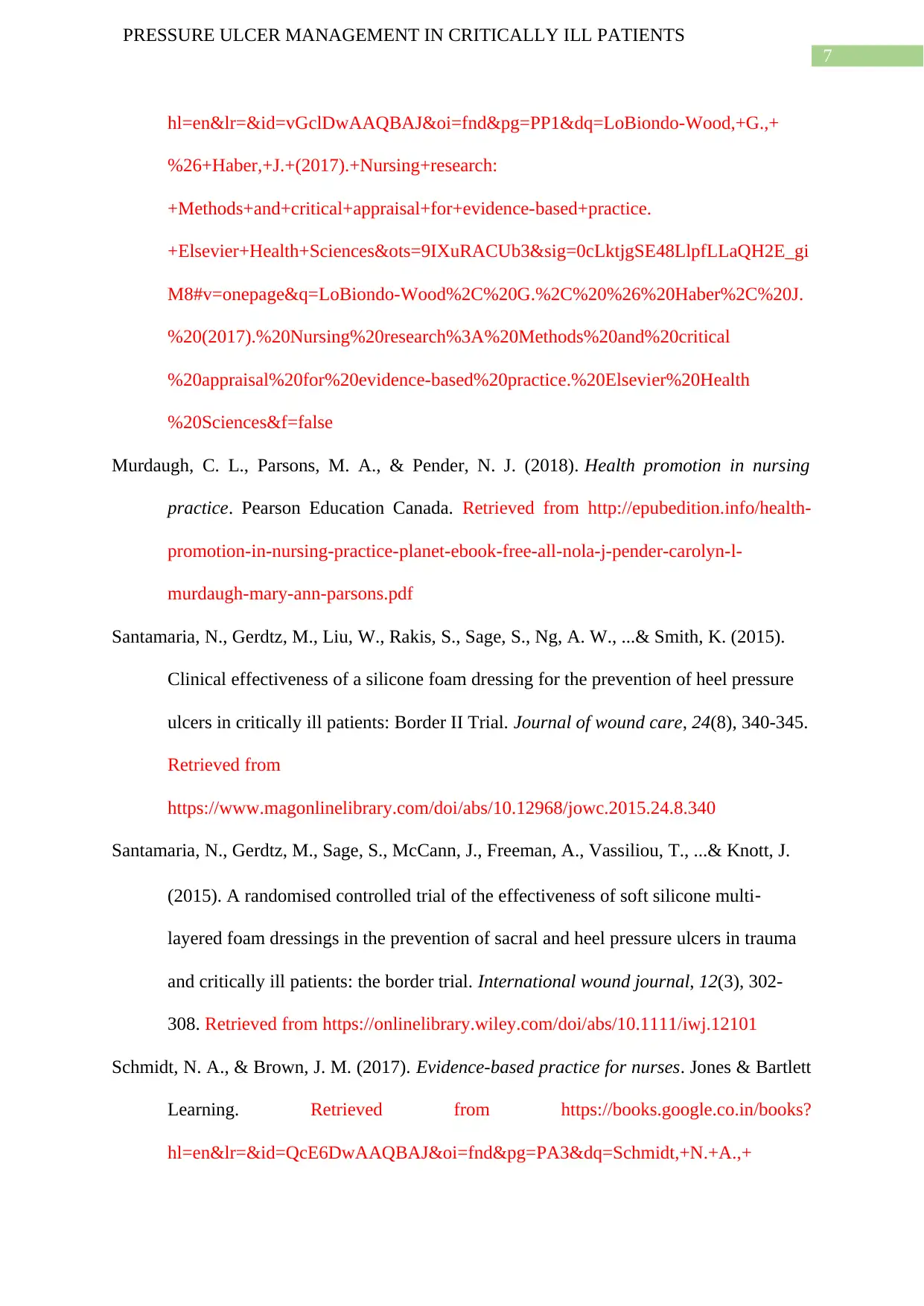
7
PRESSURE ULCER MANAGEMENT IN CRITICALLY ILL PATIENTS
hl=en&lr=&id=vGclDwAAQBAJ&oi=fnd&pg=PP1&dq=LoBiondo-Wood,+G.,+
%26+Haber,+J.+(2017).+Nursing+research:
+Methods+and+critical+appraisal+for+evidence-based+practice.
+Elsevier+Health+Sciences&ots=9IXuRACUb3&sig=0cLktjgSE48LlpfLLaQH2E_gi
M8#v=onepage&q=LoBiondo-Wood%2C%20G.%2C%20%26%20Haber%2C%20J.
%20(2017).%20Nursing%20research%3A%20Methods%20and%20critical
%20appraisal%20for%20evidence-based%20practice.%20Elsevier%20Health
%20Sciences&f=false
Murdaugh, C. L., Parsons, M. A., & Pender, N. J. (2018). Health promotion in nursing
practice. Pearson Education Canada. Retrieved from http://epubedition.info/health-
promotion-in-nursing-practice-planet-ebook-free-all-nola-j-pender-carolyn-l-
murdaugh-mary-ann-parsons.pdf
Santamaria, N., Gerdtz, M., Liu, W., Rakis, S., Sage, S., Ng, A. W., ...& Smith, K. (2015).
Clinical effectiveness of a silicone foam dressing for the prevention of heel pressure
ulcers in critically ill patients: Border II Trial. Journal of wound care, 24(8), 340-345.
Retrieved from
https://www.magonlinelibrary.com/doi/abs/10.12968/jowc.2015.24.8.340
Santamaria, N., Gerdtz, M., Sage, S., McCann, J., Freeman, A., Vassiliou, T., ...& Knott, J.
(2015). A randomised controlled trial of the effectiveness of soft silicone multi‐
layered foam dressings in the prevention of sacral and heel pressure ulcers in trauma
and critically ill patients: the border trial. International wound journal, 12(3), 302-
308. Retrieved from https://onlinelibrary.wiley.com/doi/abs/10.1111/iwj.12101
Schmidt, N. A., & Brown, J. M. (2017). Evidence-based practice for nurses. Jones & Bartlett
Learning. Retrieved from https://books.google.co.in/books?
hl=en&lr=&id=QcE6DwAAQBAJ&oi=fnd&pg=PA3&dq=Schmidt,+N.+A.,+
PRESSURE ULCER MANAGEMENT IN CRITICALLY ILL PATIENTS
hl=en&lr=&id=vGclDwAAQBAJ&oi=fnd&pg=PP1&dq=LoBiondo-Wood,+G.,+
%26+Haber,+J.+(2017).+Nursing+research:
+Methods+and+critical+appraisal+for+evidence-based+practice.
+Elsevier+Health+Sciences&ots=9IXuRACUb3&sig=0cLktjgSE48LlpfLLaQH2E_gi
M8#v=onepage&q=LoBiondo-Wood%2C%20G.%2C%20%26%20Haber%2C%20J.
%20(2017).%20Nursing%20research%3A%20Methods%20and%20critical
%20appraisal%20for%20evidence-based%20practice.%20Elsevier%20Health
%20Sciences&f=false
Murdaugh, C. L., Parsons, M. A., & Pender, N. J. (2018). Health promotion in nursing
practice. Pearson Education Canada. Retrieved from http://epubedition.info/health-
promotion-in-nursing-practice-planet-ebook-free-all-nola-j-pender-carolyn-l-
murdaugh-mary-ann-parsons.pdf
Santamaria, N., Gerdtz, M., Liu, W., Rakis, S., Sage, S., Ng, A. W., ...& Smith, K. (2015).
Clinical effectiveness of a silicone foam dressing for the prevention of heel pressure
ulcers in critically ill patients: Border II Trial. Journal of wound care, 24(8), 340-345.
Retrieved from
https://www.magonlinelibrary.com/doi/abs/10.12968/jowc.2015.24.8.340
Santamaria, N., Gerdtz, M., Sage, S., McCann, J., Freeman, A., Vassiliou, T., ...& Knott, J.
(2015). A randomised controlled trial of the effectiveness of soft silicone multi‐
layered foam dressings in the prevention of sacral and heel pressure ulcers in trauma
and critically ill patients: the border trial. International wound journal, 12(3), 302-
308. Retrieved from https://onlinelibrary.wiley.com/doi/abs/10.1111/iwj.12101
Schmidt, N. A., & Brown, J. M. (2017). Evidence-based practice for nurses. Jones & Bartlett
Learning. Retrieved from https://books.google.co.in/books?
hl=en&lr=&id=QcE6DwAAQBAJ&oi=fnd&pg=PA3&dq=Schmidt,+N.+A.,+
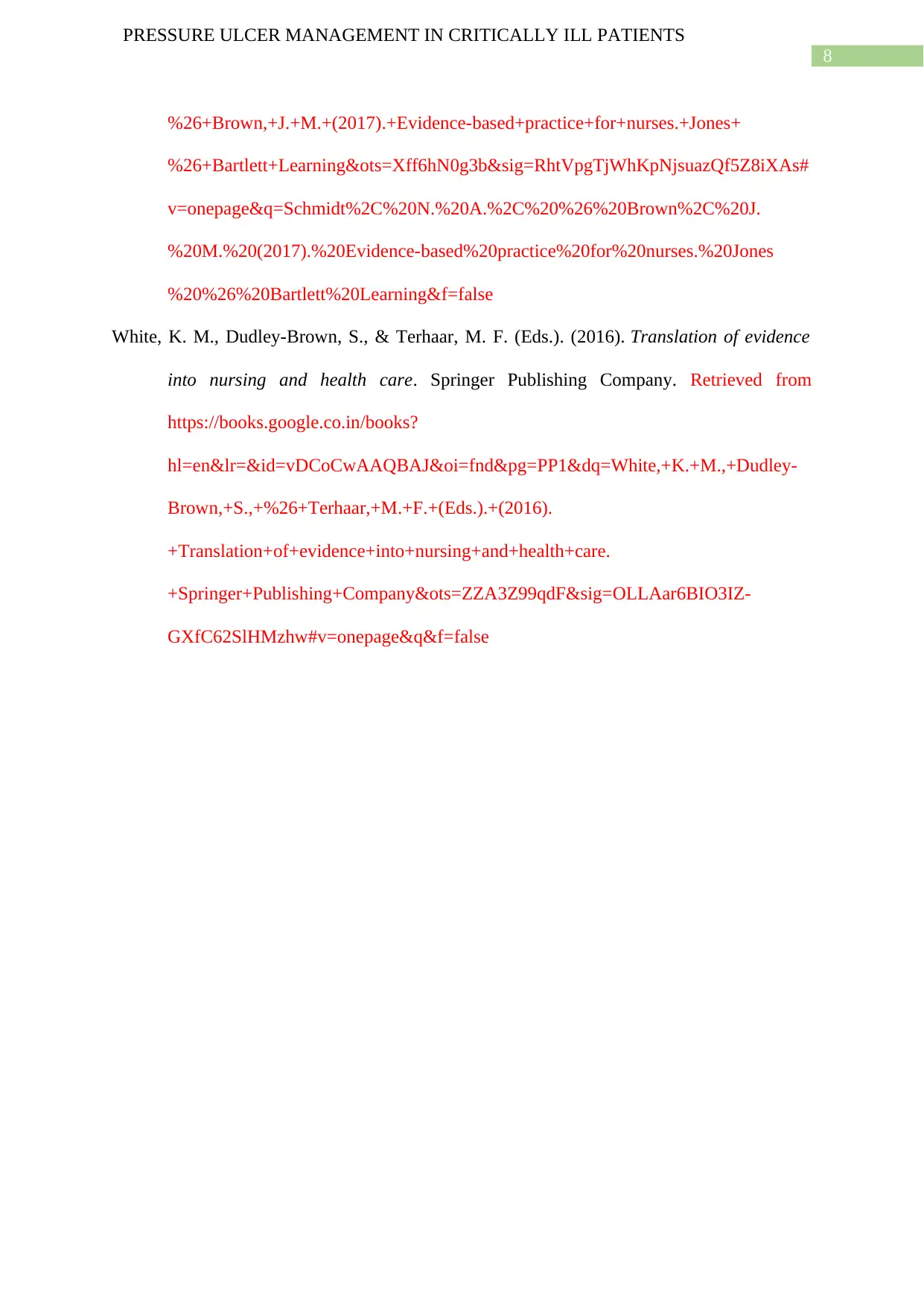
8
PRESSURE ULCER MANAGEMENT IN CRITICALLY ILL PATIENTS
%26+Brown,+J.+M.+(2017).+Evidence-based+practice+for+nurses.+Jones+
%26+Bartlett+Learning&ots=Xff6hN0g3b&sig=RhtVpgTjWhKpNjsuazQf5Z8iXAs#
v=onepage&q=Schmidt%2C%20N.%20A.%2C%20%26%20Brown%2C%20J.
%20M.%20(2017).%20Evidence-based%20practice%20for%20nurses.%20Jones
%20%26%20Bartlett%20Learning&f=false
White, K. M., Dudley-Brown, S., & Terhaar, M. F. (Eds.). (2016). Translation of evidence
into nursing and health care. Springer Publishing Company. Retrieved from
https://books.google.co.in/books?
hl=en&lr=&id=vDCoCwAAQBAJ&oi=fnd&pg=PP1&dq=White,+K.+M.,+Dudley-
Brown,+S.,+%26+Terhaar,+M.+F.+(Eds.).+(2016).
+Translation+of+evidence+into+nursing+and+health+care.
+Springer+Publishing+Company&ots=ZZA3Z99qdF&sig=OLLAar6BIO3IZ-
GXfC62SlHMzhw#v=onepage&q&f=false
PRESSURE ULCER MANAGEMENT IN CRITICALLY ILL PATIENTS
%26+Brown,+J.+M.+(2017).+Evidence-based+practice+for+nurses.+Jones+
%26+Bartlett+Learning&ots=Xff6hN0g3b&sig=RhtVpgTjWhKpNjsuazQf5Z8iXAs#
v=onepage&q=Schmidt%2C%20N.%20A.%2C%20%26%20Brown%2C%20J.
%20M.%20(2017).%20Evidence-based%20practice%20for%20nurses.%20Jones
%20%26%20Bartlett%20Learning&f=false
White, K. M., Dudley-Brown, S., & Terhaar, M. F. (Eds.). (2016). Translation of evidence
into nursing and health care. Springer Publishing Company. Retrieved from
https://books.google.co.in/books?
hl=en&lr=&id=vDCoCwAAQBAJ&oi=fnd&pg=PP1&dq=White,+K.+M.,+Dudley-
Brown,+S.,+%26+Terhaar,+M.+F.+(Eds.).+(2016).
+Translation+of+evidence+into+nursing+and+health+care.
+Springer+Publishing+Company&ots=ZZA3Z99qdF&sig=OLLAar6BIO3IZ-
GXfC62SlHMzhw#v=onepage&q&f=false
1 out of 9
Related Documents
Your All-in-One AI-Powered Toolkit for Academic Success.
+13062052269
info@desklib.com
Available 24*7 on WhatsApp / Email
![[object Object]](/_next/static/media/star-bottom.7253800d.svg)
Unlock your academic potential
© 2024 | Zucol Services PVT LTD | All rights reserved.





